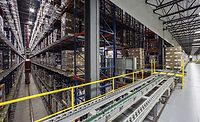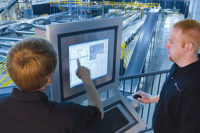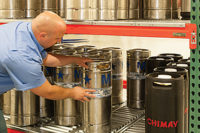Warehouse management systems integrate with warehouse control systems
Software integration aids supply-chain speed, accuracy and tracking




In an orchestra, it’s up to the conductor to ensure that all of the instruments receive the direction they need to complete a melody. However, it only takes one out-of-tune instrument to throw off the entire performance. A beverage warehouse works in a similar manner with a “conductor” in the form of warehouse management system (WMS) software ensuring that operations hum along in perfect harmony.
However, as many beverage warehouses take on more SKUs and add automation to accommodate their growing portfolios, it can be more difficult for the “orchestra” to keep up with the tempo. Thus, WMSs are evolving to keep operations running as quickly and efficiently as possible.
“SKU proliferation has been the hot topic for beverage distributors over the last few years, and advanced WMS functionality allows any size distributor to work smarter to manage the growing number of SKUs that they’re facing in an efficient manner,” says Greg Langston, director of WMS implementation at Vermont Information Processing (VIP), Colchester, Vt.
VIP offers a route accounting system that includes WMS functionality for put-away, receiving, replenishment, cycle counting, voice picking, truck loading, forecasting and location-based inventory, Langston notes. Because all of these functions are included within the same system, interfaces are not needed and systems do not have communication issues with each other, he adds. This software also helps warehouses to reduce costs, gain efficiency and improve customer service, he says.
Also acknowledging the challenge of SKU prolif-eration, Softeon Inc.’s WMS enables operators to accommodate as many SKUs as their warehouses can hold; clone a similar product for quick setup of new SKUs; zone by characteristic to allow slow-movers to be managed correctly and shorten pick paths; scan to locations to help ensure product and location accuracy; and support all categories as operations expand, notes Christian Miller, senior director of the Reston, Va.-based company.
Generally, WMS solutions offer value in the areas of resource planning, traceability, accountability and order management, says Frank Rossi, manager of North American business development for Dematic, Grand Rapids, Mich. These systems typically control financial, accounting and procurement functions as well, he adds. They also can include labor management tools, as is the case with Mason, Ohio-based Intelligrated’s WMS.
WMSs will become more vital as companies consolidate their warehouses, says John Barry, vice president of sales for ITW Warehouse Automation, Arden, N.C.
“The beverage industry is going to try to bring as much volume under one roof as possible to consolidate costs,” he says. “With this said, the requirements of your automation will require a strong WMS system.”
Conducting assistance
In many cases, “sub-conductors” — also known as warehouse control system (WCS) software — are needed to help manage the warehouse, notes Dave Williams, director of software and solution delivery for Westfalia Technologies Inc., York, Pa. WCSs typically execute the automated parts of the facility, such as automated storage and retrieval systems and conveyors, he says.
In recent years, WCSs have grown to include inventory capture and control capabilities as well as increased tracking and reporting, Dematic’s Rossi says.
As automation becomes more prominent in beverage warehouses, WCSs are becoming more important, notes Greg Cronin, executive vice president of Intelligrated.
System harmonization
Nevertheless, perhaps the most prominent, recent trend in this space is the integration of WMSs and WCSs, Westfalia’s Williams says.
“One of the new terminologies that’s being used around the industry now is warehouse execution systems, where they do both — the WMS functionality and the WCS functionality,” he explains. “As automation increases in various industries, many traditional warehouse control systems are starting to provide more warehouse management functionality, and also many of the traditional warehouse management systems are starting to dive in and communicate directly with some of the equipment and so forth.”
For instance, Westfalia’s Savanna.Net software is a warehouse execution system that features both WMS and WCS functionalities.
This integration, in turn, enables warehouses to move toward just-in-time deliveries with less inventory on hand and also increase inventory accuracy, improve tracking and achieve more efficient and accurate order fulfillment, Williams says.
The integration of the systems also enables warehouses to evolve in terms of speed, Intelli-grated’s Cronin says. One of the main reasons that a warehouse invests in automation is to increase the speed of its operations, so “the worst thing you could do is slow down the automation,” he notes.
Typically, automation runs faster than WMSs can handle, so a role of WCSs in the past was to act as a buffer and coordinate information between the two, Cronin explains. With the industry’s increased investments in automation, integrated WMS and WCS solutions now have the ability to direct activity in a much more high-speed mode than traditional systems, Cronin says.
Integrating WMS and WCS solutions also can boost the return on investment, Westfalia’s Williams notes.
“The more you head toward the direction of a true warehouse execution system where it contains both functions of a WMS and a WCS, the less cost there is to the customer putting those systems in, because it’s more of a seamless integration,” he explains.
Cloud deployments also have made WMSs more affordable, notes Softeon’s Miller. Cloud-based systems allow for externally managed server hardware and managed costs of deployment and maintenance, Dematic’s Rossi adds.
The next composition
As the move to the cloud gains traction in the industry, new hardware also will become more prominent within WMSs, according to suppliers.
“The advent of smart mobile devices will provide a more intuitive operator experience, reduce training, and empower operators to be able to retrieve information when needed,” Dematic’s Rossi says. This includes both iOS- and Android-based smartphones and tablets, which will replace or augment the standard handheld RF devices, he notes.
This move coincides with the advent of next-generation workers, who are familiar with and prefer to use mobile technologies, Intelligrated’s Cronin notes.
“In the old days, it used to be a big CRT screen … that everybody would accumulate around and look at what performance is and where the work is to be done,” he explains. “Now, you want people to be on the fly, on the move, interacting with the system.”
As the industry continues to change and evolve, WMSs will remain responsible for knowing all the different aspects of a warehouse, including top sellers, items on sale and equipment functionality, to ensure that products are stored most efficiently, workers can pick items quickly and accurately, and equipment stays up and running, Cronin says. As a result, facilities can produce a supply-chain symphony without skipping a beat.
Looking for a reprint of this article?
From high-res PDFs to custom plaques, order your copy today!










